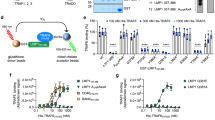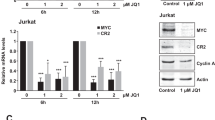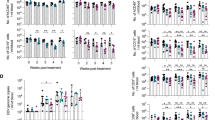Abstract
Epstein–Barr virus (EBV)-immortalized lymphoblastoid cells express high levels of lymphotoxin and use this molecule as an autocrine growth factor. We hypothesized that the EBV-derived latent membrane protein 1 (LMP1) mediates lymphotoxin production by inducing NF-κB binding to the lymphotoxin promoter. We assessed lymphotoxin production, LMP1 expression, and NF-κB activation in Z-43 (EBV-positive lymphoblastoid cells), Daudi (EBV-positive Burkitt's cells), and 3A4 (EBV-negative Burkitt's cells containing a stably transfected tetracycline-inducible LMP1 construct). Z-43 cells expressed high levels of LMP1 (immunoblot) and lymphotoxin (ELISA); the EBV-positive Burkitt's lymphoma line Daudi expressed neither LMP1 nor lymphotoxin. Similarly, induction of LMP1 in the 3A4 cells (exposed to tetracycline) was accompanied by a 13-fold increase in lymphotoxin levels (ELISA) as compared to uninduced (LMP1-negative) cells. EMSAs demonstrated high levels of NF-κB activation in Z-43 and tetracycline-induced 3A4 cells, but much lower levels in the uninduced 3A4 cells. Exposure of these cells to Bay 11-7082 (an inhibitor of IκB phosphorylation and, therefore, NF-κB activation) abrogated NF-κB binding and lymphotoxin production in a dose-dependent manner in both Z-43 and 3A4 cells. Therefore, in our model system, autocrine lymphotoxin production is largely driven by NF-κB activation, which is in turn mediated by EBV-derived LMP1 signaling.
This is a preview of subscription content, access via your institution
Access options
Subscribe to this journal
Receive 12 print issues and online access
$259.00 per year
only $21.58 per issue
Buy this article
- Purchase on Springer Link
- Instant access to full article PDF
Prices may be subject to local taxes which are calculated during checkout




Similar content being viewed by others
References
Burkitt DP . A sarcoma involving the jaws in African children. Br J Surg 1958; 46: 218–223.
Epstein MA, Achong B, Barr Y . Virus particles in cultured lymphoblasts from Burkitt's lymphoma. Lancet 1964; 1: 702–708.
Baumforth KRN, Young LS, Flavell KJ, Constandinou C, Murray PG . The Epstein–Barr virus and its association with human cancers. J Clin Pathol Mol Pathol 1999; 52: 307–322.
Cohen J . Epstein–Barr virus infection. N Engl J Med 2000; 343: 481–492.
Ambinder R, Lemas M, Moore S, Yang J, Fabian D, Krone C . Epstein–Barr virus and lymphoma. In: Tallman M, Gordon L (eds). Diagnostic and Therapeutic Advances in Hematologic Malignancies. Boston: Kluwer Academic Publishers, 1999, pp 27–38.
Henle W, Diege G, Kohn H, Zur Hausen H, Henle G . Herpes-type virus and chromosome marker in normal leukocytes after growth with irradiated Burkitt cells. Science 1967; 157: 1064–1065.
Diehl V, Henle W, Henle G, Kohn G . Demonstration of a herpes group virus in cultures of peripheral leukocytes from patients with infectious mononucleosis. J Virol 1968; 2: 663–669.
Pulvertaft R . Cytology of Burkitt's tumor (African tumor). Lancet 1964; 7: 238–243.
Blazar B, Sutton L, Strome M . Self-stimulating growth factor production by B-cell lines derived from Burkitt's lymphoma and other lines transformed in vitro by Epstein–Barr virus. Cancer Res 1983; 43: 4562–4568.
Gordon J, Ley S, Melamed M, Aman P, Hughes-Jones NC . Soluble factor requirements for the auto-stimulatory growth of B lymphoblasts immortalized by Epstein–Barr virus. J Exp Med 1984; 159: 1554–1559.
Gordon J, Ley S, Melamed M, English LS, Hughes-Jones NC . Immortalized B-lymphocytes produce B-cell growth factor. Nature 1984; 310: 145–147.
Tosato G, Gerrar T, Goldman N, Pike S . Stimulation of EBV-activated human B-cells by monocytes and monocyte products. Role of INF-β2/B-cell stimulatory factor 2/IL-6. J Immunol 1988; 140: 4329–4336.
Estrov Z, Kurzrock R, Pocsik E, Pathak S, Kantarjian HM, Zipf TF et al. Lymphotoxin is an autocrine growth factor for Epstein–Barr virus-infected B-cell lines. J Exp Med 1993; 177: 763–774.
Zimber-Strobl U, Kempkes B, Marschall G, Zeidler R, Van Kooten C, Banchereau J et al. Epstein–Barr virus latent membrane protein (LMP1) is not sufficient to maintain proliferation of B cells but both it and activated CD40 can prolong their survival. EMBO J 1996; 15: 7070–7078.
Gires O, Zimber-Strobl U, Gonnella R, Ueffing M, Marschall G, Zeidler R et al. Latent membrane protein 1 of Epstein–Barr virus mimics a constitutively active receptor molecule. EMBO J 1997; 16: 6131–6140.
Baichwal VR, Sugden B . Transformation of Balb-3T3 cells by the BNLF-1 gene of Epstein–Barr virus. Oncogene 1988; 2: 461–467.
Wang D, Liebowitz D, Kieff E . An EBV membrane protein expressed in immortalized lymphocytes transforms established rodent cells. Cell 1985; 43: 831–840.
Eliopoulos A, Dawson C, Mosialos G, Floettmann JE, Rowe M, Armitage RJ et al. CD40-induced growth inhibition in epithelial cells is mimicked by Epstein–Barr virus-encoded LMP1: involvement of TRAF3 as a common mediator. Oncogene 1996; 13: 2243–2254.
Devergne O, Hatzivassiliou E, Izumi K, Kaye KM, Kleijnen MF, Kieff E et al. Association of TRAF1, TRAF2, and TRAF3 with an Epstein–Barr virus LMP1 domain important for B-lymphocyte transformation: role in NF-kappaB activation. Mol Cell Biol 1996; 12: 7098–7108.
Liebowitz D . Epstein–Barr virus and a cellular signaling pathway in lymphomas from immunosuppressed patients. N Engl J Med 1998; 338: 1413–1421.
Izumi K, Kieff E . The Epstein–Barr virus oncogene product latent membrane protein 1 engages the tumor necrosis factor associated death domain protein to mediate B lymphocyte growth transformation and NF-κB activation. Proc Natl Acad Sci USA 1997; 94: 12592–12597.
Miller W, Mosialos G, Kieff E, Raab-Traub N . Epstein–Barr virus LMP1 induction of the epidermal growth factor receptor is mediated through a TRAF signaling pathway distinct from NF-κB activation. J Virol 1997; 1: 586–594.
Mosialos G, Birkenbach M, Yalamanchili R, VanArsdale T, Ware C, Kieff E . The Epstein–Barr virus transforming protein LMP1 engages signaling proteins for the tumor necrosis factor receptor family. Cell 1995; 10: 389–399.
Huen DS, Henderson SH, Croom-Carter D, Rowe M . The Epstein–Barr virus latent membrane protein (LMP1) mediates activation of NF-κB and cell surface phenotype via two effector regions in its carboxyl-terminal cytoplasmic domain. Oncogene 1995; 10: 549–560.
Eliopoulos AG, Young LS . Activation of the cJun N-terminal kinase (JNK) pathway by the Epstein–Barr virus encoded latent membrane protein-1. Oncogene 1998; 6: 1731–1742.
Eliopoulos AG, Gallagher NJ, Blake SMA, Dawson CW, Young LS . Activation of the p38 mitogen activated protein kinase pathway by Epstein–Barr virus-encoded latent membrane protein 1 coregulates interleukin-6 and interleukin-8 production. J Biol Chem 1999; 274: 16085–16096.
Gires O, Kohlhuber F, Kilger E, Baumann M, Kieser A, Kaiser C et al. Latent membrane protein 1 of Epstein–Barr virus interacts with JAK3 and activates STAT proteins. EMBO J 1999; 18: 3064–3073.
Herrero J, Matthew P, Paya C . LMP-1 activates NF-κB by targeting the inhibitory molecule IκBα. J Virol 1995; 69: 2168–2174.
Sylla B, Hung S, Davidson D, Hatzivassiliou E, Malinin NL, Wallach D et al. Epstein–Barr virus transforming protein latent infection membrane protein 1 activates transcription factor NF-κB through a pathway that includes the NF-κB-inducing kinase and the IκB kinases IKKα and IKKβ. Proc Natl Acad Sci USA 1998; 95: 10106–10111.
Mitchell T, Sugden B . Stimulation of NF-κB-mediated transcription by mutant derivatives of the latent membrane protein of Epstein–Barr virus. J Virol 1995; 69: 2968–2976.
Messer G, Weiss E, Baeuerle P . Tumor necrosis factor β (TNF-β) induces binding of the NF-κB transcription factor to a high-affinity κB element in the TNF-β promoter. Cytokine 1990; 2: 389–397.
Paul N, Lenardo M, Novak K, Sarr T, Tang WL, Ruddle NH . Lymphotoxin activation by human T-cell leukemia virus type 1-infected cell lines: role for NF-κB. J Virol 1990; 64: 5412–5419.
Clements G, Klein G, Povey S . Production by EBV infection of an EBNA-positive subline from an EBNA-negative human lymphoma cell line without detectable EBV DNA. Int J Cancer 1975; 16: 125–133.
Kaykas A, Sugden B . The N-terminus and membrane spanning domains of LMP-1 inhibit cell proliferation. Oncogene 2000; 19: 1400–1410.
Pierce J, Schoenleber R, Jesmok G, Best J, Moore SA, Collins T et al. Novel inhibitors of cytokine-induced IkappaBalpha phosphorylation and endothelial cell adhesion molecule expression show anti-inflammatory effects in vivo. J Biol Chem 1997; 272: 21096–21103.
Mann K, Staunton D, Thorley-Lawson D . An Epstein–Barr virus-encoded protein found in the plasma membranes of transformed cells. J Virol 1985; 55: 710–720.
Kawa K . Epstein–Barr virus-associated diseases in humans. Int J Hematol 2000; 71: 108–117.
Gray PW, Aggarwal BB, Benton CV, Bringman TS, Henzel WJ, Jarrett JA et al. Cloning and expression of cDNA for human lymphotoxin, a lymphokine with tumour necrosis activity. Nature 1984; 312: 721–724.
Pennica D, Nedwin G, Hayflick JS, Seeburg PH, Derynck R, Palladino MA et al. Human tumour necrosis factor: precursor structure, expression and homology to lymphotoxoin. Nature 1984; 312: 724–729.
McClain K, Estrov Z, Raju U, Kelley P, Aggarwal BB . Epstein–Barr virus EBNA2 gene expression enhances lymphotoxin production by B-lymphocytes. Methods 1997; 11: 83–87.
Paul N, Millet I, Ruddle N . The lymphotoxin promoter is stimulated by HTLV-1 tax activation of NF-κB in human T-cell lines. Cytokine 1993; 5: 372–378.
Author information
Authors and Affiliations
Rights and permissions
About this article
Cite this article
Thompson, M., Aggarwal, B., Shishodia, S. et al. Autocrine lymphotoxin production in Epstein–Barr virus-immortalized B cells: induction via NF-κB activation mediated by EBV-derived latent membrane protein 1. Leukemia 17, 2196–2201 (2003). https://doi.org/10.1038/sj.leu.2403130
Received:
Accepted:
Published:
Issue Date:
DOI: https://doi.org/10.1038/sj.leu.2403130
Keywords
This article is cited by
-
Molecular impact of selective NFKB1 and NFKB2 signaling on DLBCL phenotype
Oncogene (2017)
-
The B cell transcription program mediates hypomethylation and overexpression of key genes in Epstein-Barr virus-associated proliferative conversion
Genome Biology (2013)
-
Raf and VEGF: emerging therapeutic targets in Kaposi's sarcoma-associated herpesvirus infection and angiogenesis in hematopoietic and nonhematopoietic tumors
Leukemia (2005)



